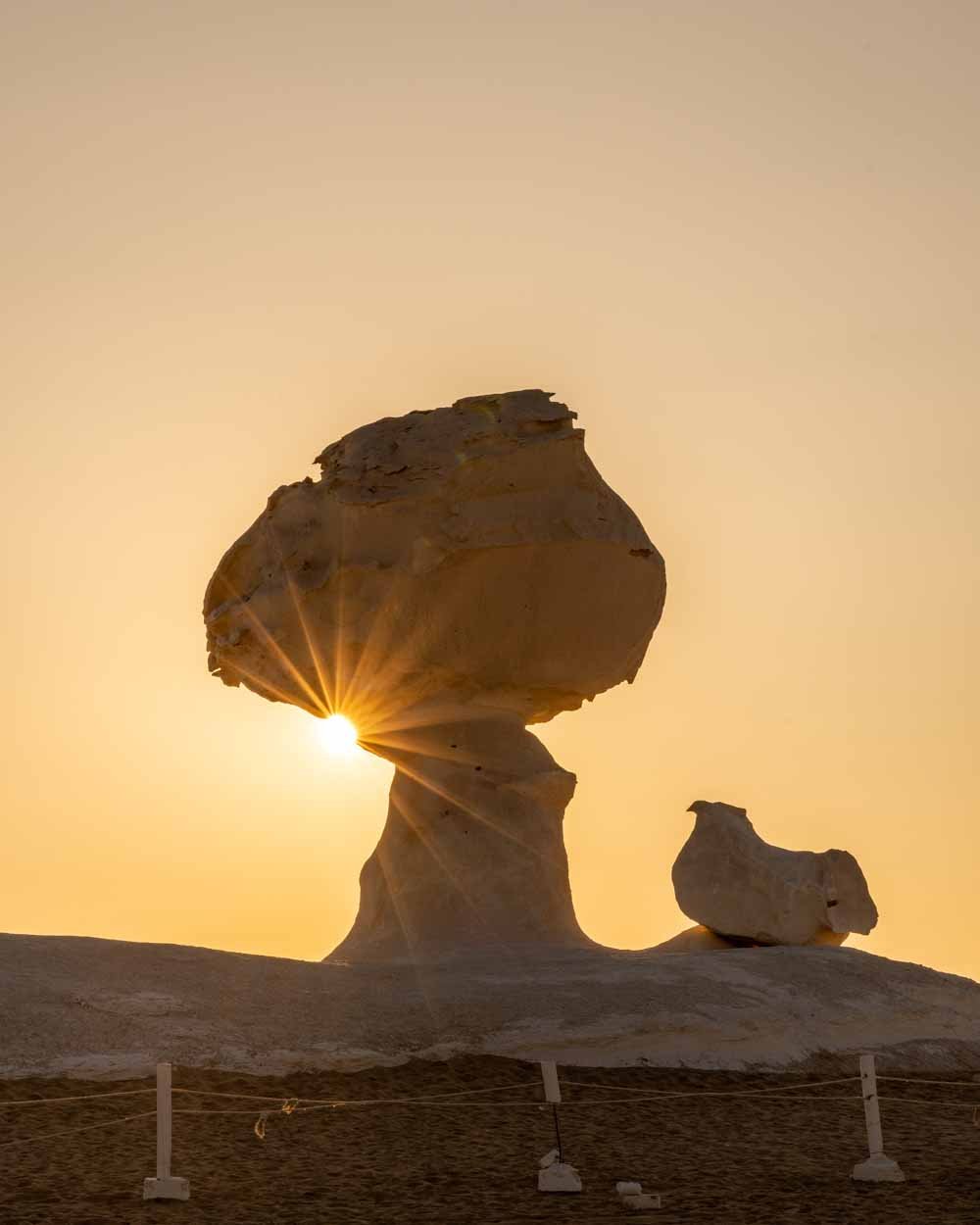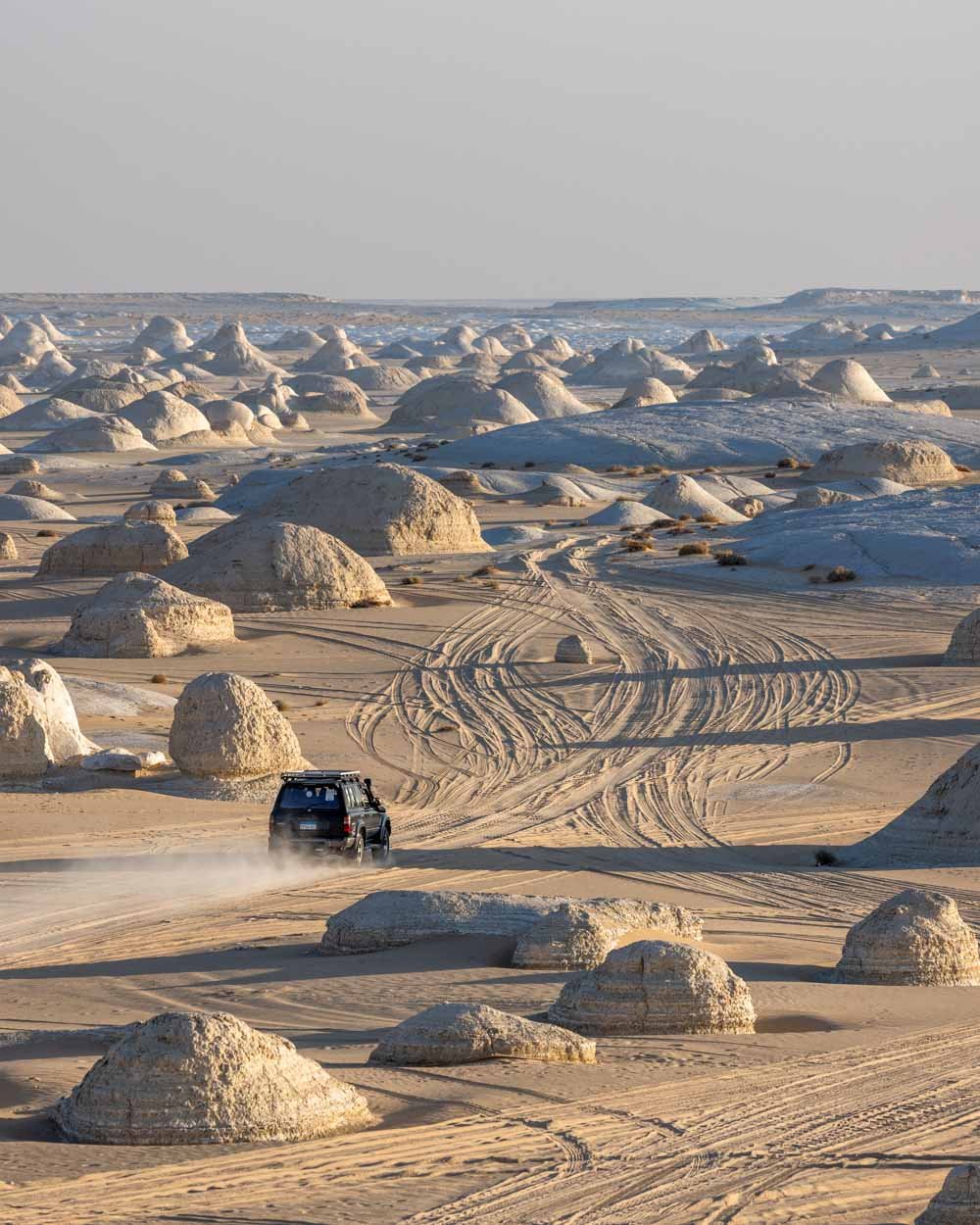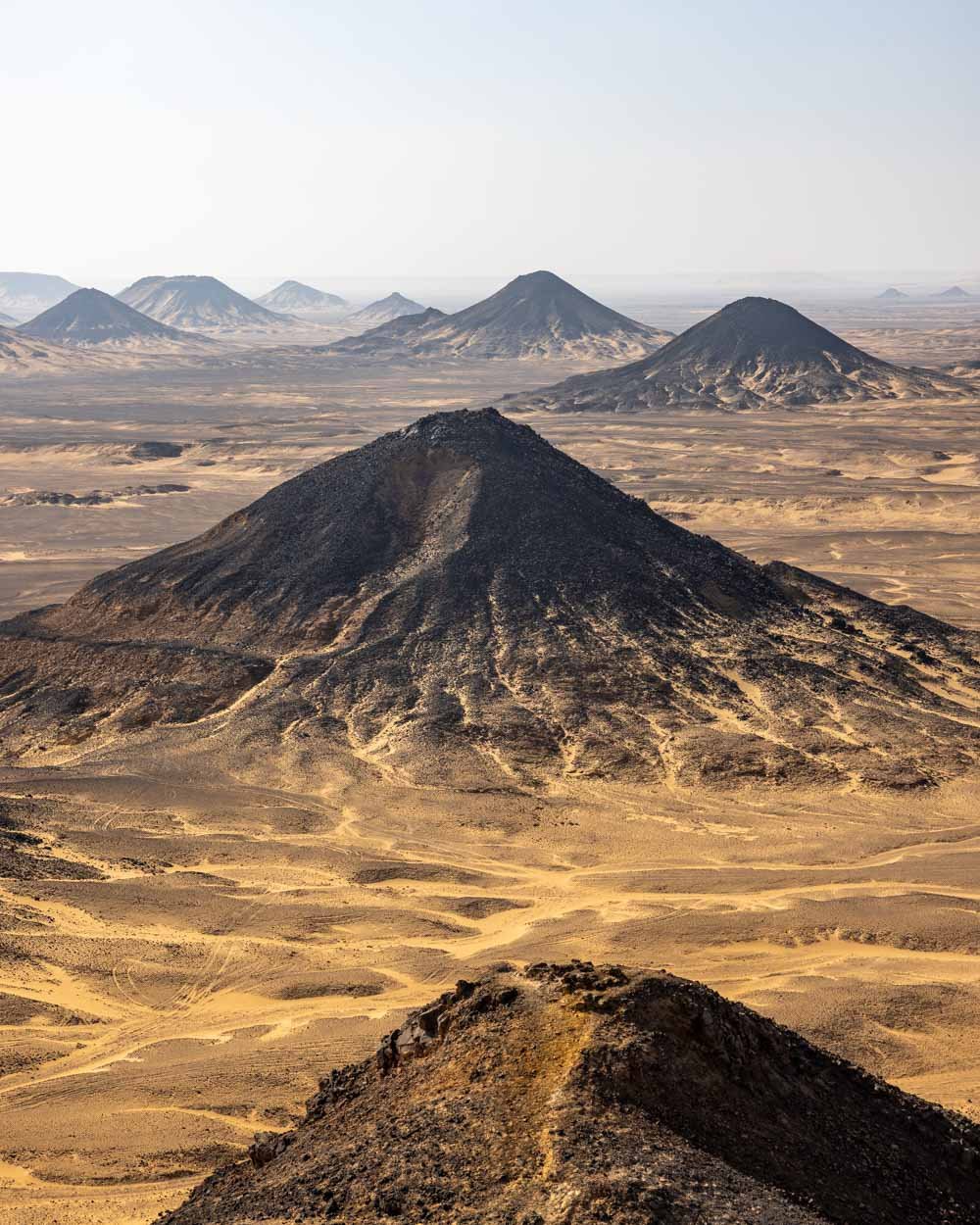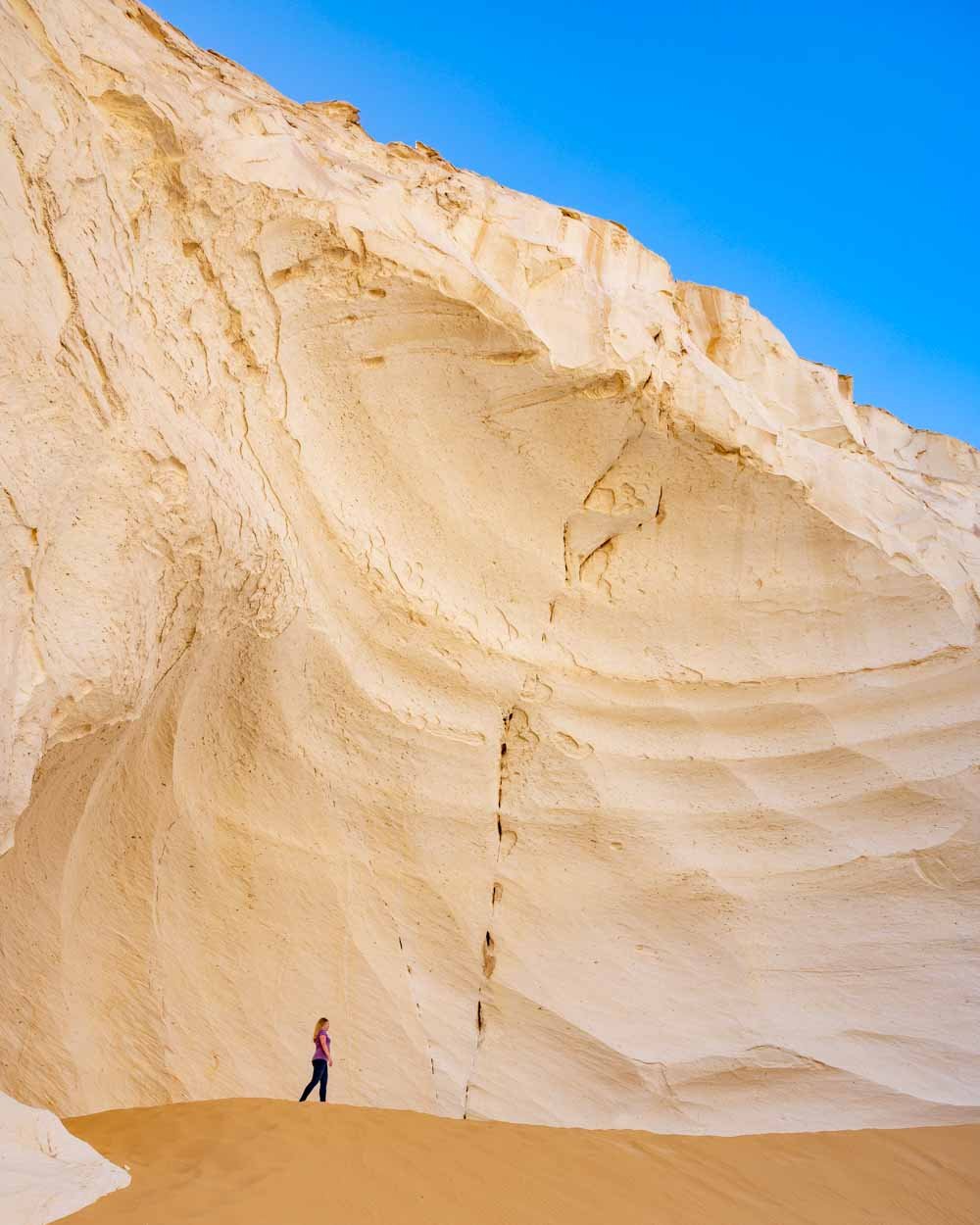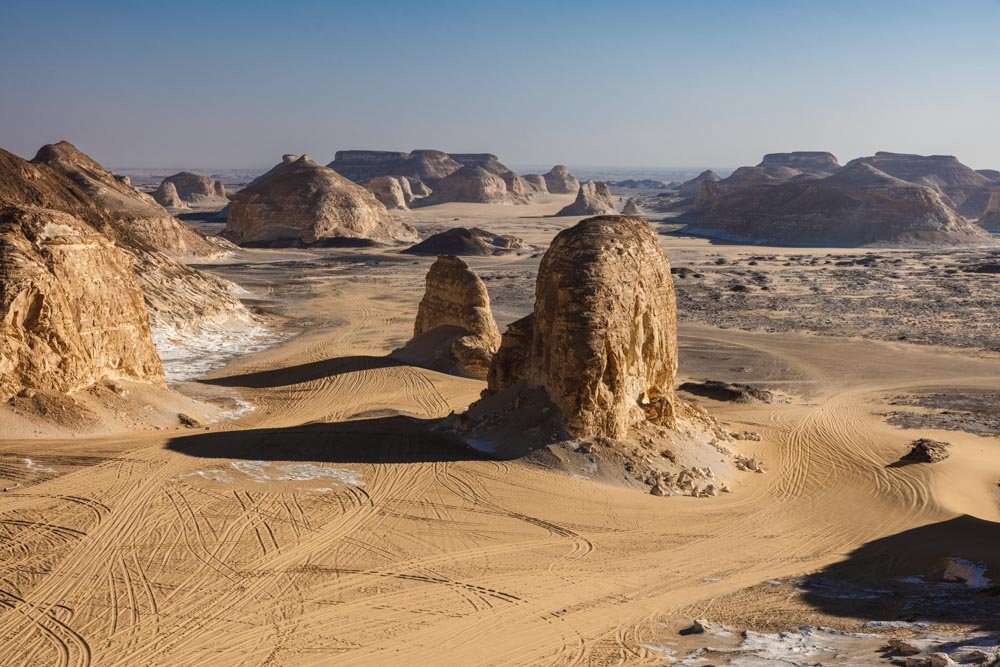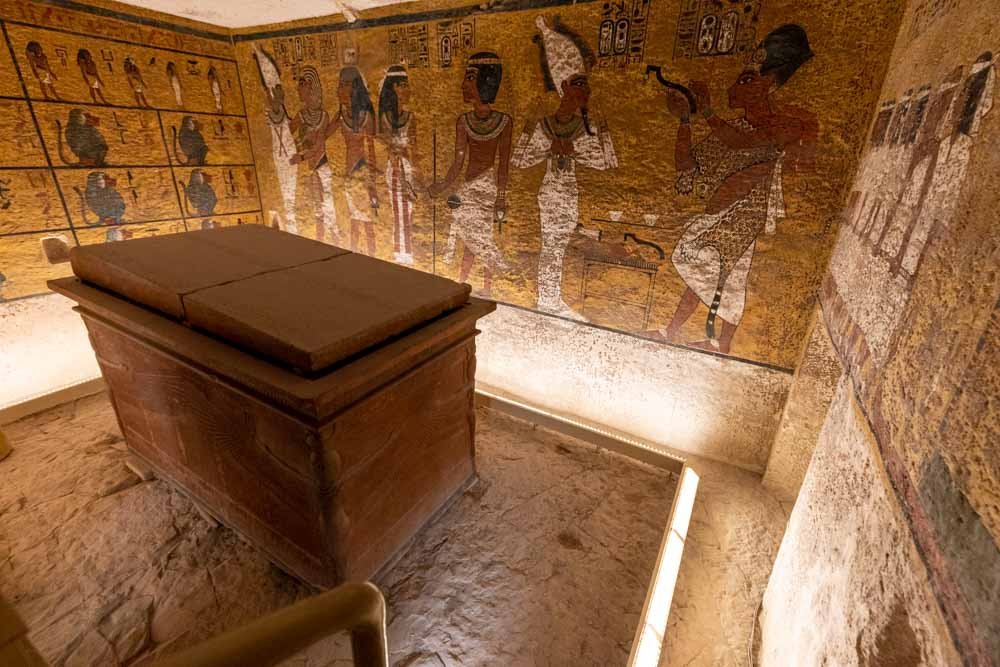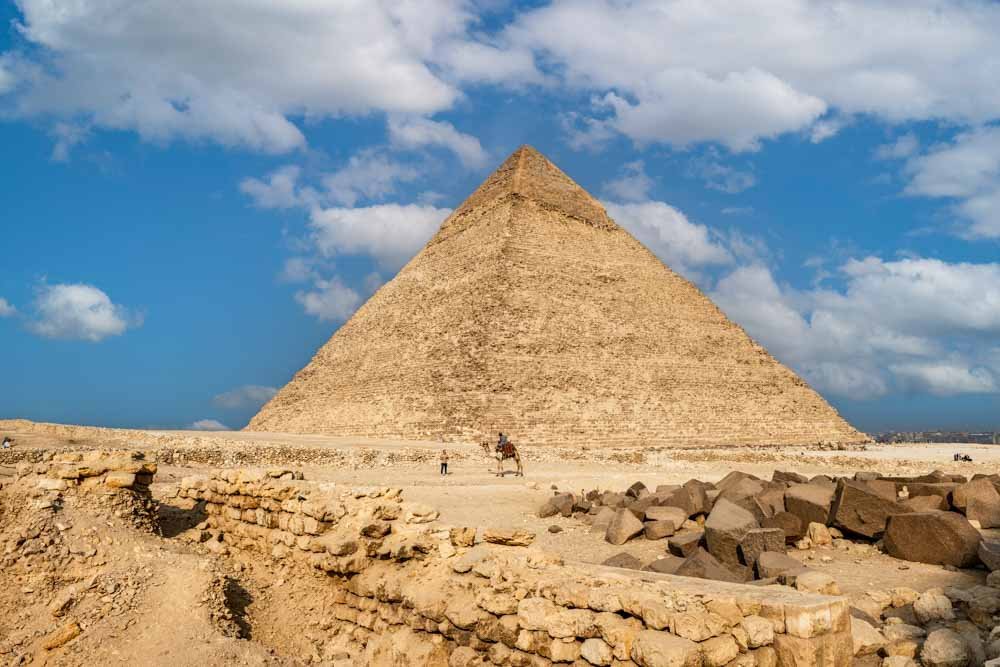In a country packed with world class bucket list places like the Pyramids of Giza, I was more than a little surprised when I heard from so many people that the White Desert was their favourite place in Egypt. I wasn’t convinced that would be the case for us, (spoiler alert: it wasn’t) but I’d heard enough people wax lyrical that I knew we had to go.
I’m not going to tell you that the White Desert isn’t beautiful: it definitely is. And overall we did enjoy our trip, however, it won’t be for everyone.
In this guide, we’re going to run through all the stops your average two day, one night tour will make, and what we thought of each one, as well as our general desert experience.
Here’s everything you need to know about visiting Egypt’s White Desert.
Things to know before visiting the White Desert
1. It’s no hidden gem
Before we get started on the stops, I just wanted to address the fact that the White Desert might not be the off the beaten track experience you think it will. It’s widely touted as being one of Egypt’s best hidden gems, and whilst your friends at home might not have heard of it, a significant number of people visiting Egypt have!
Now I am not knocking the articles describing it as a hidden gem, it obviously would have been in the past - we’re guilty of writing about a place which was a hidden gem that later becomes popular, and we forget to ever go back and change the description. I simply want to highlight that the White Desert is very, very popular.
We were actually shocked by the sheer volume of Landcruisers tearing through the desert, and we’d asked to tailor the itinerary to visit the spots at different times to the majority of tour groups!
However, it wasn’t just the 4WD’s during the day time that was a bit of a surprise, it was also the amount of campsites in the desert in the evening. We could hear music from other camps and it was actually hard at times to find a spot to go to the toilet where you weren’t in view of another campsite…….
I’m not saying don’t visit the desert because it’s no longer a hidden gem, but I do want to manage your expectations!
If you want a proper offbeat desert experience, then I’d recommend taking an overnight trip into the Sinai, or one of the longer trips into the White Desert (that take you to the quieter spots as few people stay more than one night).
2. You have to enjoy a certain kind of tour
I want to preface this by saying our tour guide was really good, but the kind of tours you can do in the White Desert aren’t our favourite.
Essentially you’ll stop briefly at a site for a little wander and a few photo ops, and then head on to the next stop. Absolutely nothing wrong with that, and I don’t mean it negatively, but it doesn’t really suit our style of travel.
We love photography and take a huge amount of photos, but we’re not really into just stopping for photos - or taking pictures of rocks that look like a rabbit, toilet, snake etc etc.
There aren’t really any walks or stops that are a bit more involved in the desert, so it all feels a bit stop, start. The exception to this is probably the sand boarding, which we actually chose not to do as we were quite limited on time and wanted to make sure we caught sunset in the White Desert.
I don’t want to compare everything to the Sinai, but in contrast, the tours we took there included visits to ancient rock art sites, caves and canyons, so it was more active and less about simply taking a nice picture. How much you enjoy the White Desert will partly come down to your preference when it comes to tours.
3. You spend most of your time in the car
It takes roughly five hours to get from Cairo to where you begin your trip into the desert. The White Desert is roughly another two hours of driving (via a variety of stops). This means that on your two day one night tour, you are in the car for more than 14 hours.
Only a very small portion of that (we estimate less than 1.5 hours) is driving on the sand - ie scenic. The vast majority is on paved roads, which are not so exciting.
4. Tours are rustic
Unlike desert tours in places like Wadi Rum in Jordan, trips into the White Desert are very rustic. This is a proper back to nature experience in that sense. You’ll be sleeping in a tiny tent (unless you luck out and get something more, but we mainly passed camps with the same small tent we had) and there are no toilets or running water. You might have assumed this was the case anyway given it’s a desert, but in Wadi Rum, there are both proper rooms and bathrooms, so it’s not always the case.
Many people will love the fact it’s still very simple and that it’s a real wilderness experience, but it won’t be for everyone. We’d recommend bringing toilet paper, a lighter (to burn the paper) and wet wipes.
5. The night time is the most special part
I would strongly recommend that you don’t take a day trip to the White Desert. Not only will you have to do all the driving on one day, but the night time is the best part.
Sitting out under the most incredible night sky with endless cups of tea boiling on the open fire was very special. This is the bit of the trip I will always remember. You could still see the outlines of some of the oddly shaped rock formations and both the landscape and night sky felt so vast.
We didn’t get a sunrise sadly as it was fully overcast, but I can imagine that would normally be absolutely beautiful as well.
6. The desert is unique
We’ve been to a lot of spectacular deserts, yet we’ve never seen one quite like the White Desert. The sheer number of crazy rock formations, coupled with the pure white colour made it a truly unique sight.
It might not have been our kind of tour, but that definitely doesn’t mean that the desert itself isn’t amazing. I can imagine back in the day when it wasn’t so busy, it would have been even more magical.
7. It’s hard to customise your tour
Anyone who followed our trip to Jordan will probably see history repeating itself here. In Wadi Rum desert we booked a hiking trip which turned out to be a bit of a farce - you can read about it here - and in the White Desert we also tried to alter the trip to better suit us.
Although you couldn’t make it into a hiking trip, we did say we wanted to avoid the crowds and focus on beautiful landscapes, rather than cheesy photo ops (think the aforementioned toilet shaped rocks etc). As with Wadi Rum, it didn’t quite work out.
Yes, we did for the most part go against the flow of crowds (until they caught up with us in the late afternoon) but unless you spend more than one night in the desert, there aren’t really any different stops you can make. All tours visit the same places and there aren’t really any ‘hidden gems’. Unlike in Jordan where there were offbeat spots that our guide didn’t take us to, in Egypt this wasn’t the case.
As mentioned this is different if you stay longer because the vast majority of people only do one night trips. However, I am not sure you’re doing much more than additional photo spots in different parts of the desert - from what I could gather from guides anyway.
8. It’s technically in most government’s yellow/orange zones
At time of writing, the Western Desert (White Desert) falls under the Foreign Office’s ‘advise against all but essential travel zone’ for Brits. In America, the State Department class it under the “do not travel zone” and the Australian government classifies the region under the category “reconsider your need to travel”. However, both America and Australia don’t have any part of Egypt in a green zone. This differs to the UK in which almost all of Egypt is in a green zone.
The reason for the advice against travelling in the Western Desert is due to its location, close to the border of Libya and Sudan, and the worry that people could illegally cross the desert into Egypt. We couldn’t possibly give advice about how you should take this information, but what we do know is that the Egyptian army has a very heavy presence in the Western Desert (you might have been wondering why there could possibly be phone signal somewhere so remote….) and many, many tour groups visit without incident every day.
We heard that there hadn’t been an incident here involving tourists since 2015 - but please don’t take that as gospel because we couldn’t verify it online.
It’s up to each individual how they feel about this, but personally we felt very safe - as we did throughout Egypt. Security has been ramped up to such a degree in recent times that I honestly felt safer than I do in London.
Stops on the White Desert tours
We visited some of these spots in a slightly different order to most to try and avoid the crowds. We’d recommend doing the same if you’re on a private tour and have some control over your itinerary.
Stop 1: The Black Desert
The first stop is almost always the Black Desert. It’s located along a paved road and not so far from the main town of Bawiti, where you will have already stopped for lunch.
We were offered two options here: to climb a hill to get a good view, or to walk a little through the desert. We opted for the hill because we wanted the view. The walk is only 300m each way, but you’ll climb 70m in elevation, which makes it very steep over such a short distance.
The terrain is loose scree after the first 150m which is very slippery (more on the ascent than the descent). Although the best views are from the top, if you don’t like the look of the scree, you still get a good view at the 150m mark.
The Black Desert stop tends to last around 30 minutes, but if you’re on a private tour then you won’t usually be chivvied on. It’s a fantastic landscape, but you are right beside the road, so it’s not as wild as I assumed it would be when I’d initially seen photos.
Stop 2: The Valley of Agabat
Stop two for us, (but usually later in the day), was the Valley of Agabat. You’ll do your first bit of desert driving to reach it and you can choose to sit on top of the car if you don’t mind a bumpy ride! If you suffer from motion sickness make sure you’re in the front, or on top of the car.
The entry to the Valley of Agabat is stunning. Your car will stop just before the downhill into the valley and this offers one of the best views of the trip. The vast desert with its tall rock formations is very dramatic.
You can climb the rocky cliff to the right of the ‘road’ for more elevated views. It only takes a few minutes and can be a touch slippery, but nothing like the Black Desert hill.
Once you’ve enjoyed the view, ask your driver to take the left hand trail (most cars seemed to go right) as this leads to a little overhang.
You wouldn’t think anything of it from below, but when you climb up into it (steep, but only takes a minute) you can get some good pictures of the white cave opening. It’s well worth stopping to take a look.
Stop 3: Sand boarding
As mentioned we didn’t do this, but all tours that we heard about, including ours, offered it as an option. You’ll be taken to a steep sand dune and given a wooden board to surf down on. You can then run back up and do it all again!
Stop 4: The Old White Desert
After leaving the Valley of Agabat you’ll drive through the desert for a short time before hitting a paved road again. You’ll then spend a little time on the tarmac before veering off into the Old White Desert. The Old White Desert is less white than the White Desert, but still whitish. More a grey white than the pure white of the new desert.
At first you’re driving through large mushroom like rock formations, which are relatively sparse, but they soon get more dense. My favourite bit was the ‘viewpoint’, which is slightly elevated and overlooks so many little rock formations that it’s really quite an extraordinary sight.
After this we drove through to the New White Desert. However on day two we stopped again at a different viewpoint in the Old White Desert, which was also quite something.
It’s just a small rocky area, but after a two minute climb you get some fabulous 360 degree views of the rock formations.
Stop 5: The New White Desert
The New White Desert is everyone’s last stop of the day. This is the creme de la creme of the trip. The other landscapes we’d seen had been beautiful, but not dissimilar to other deserts we’ve been to, the New White Desert was unique.
The rock formations get bigger, but it’s the pure white colour that makes it a magical scene. There are even sections of what look like white waves, and the whole effect is dazzling.
The most famous of the rock formations, the mushroom and chicken, are roped off for their protection, but otherwise it all feels wild and natural.
Almost every tour seems to converge on the mushroom and chicken for sunset, so we asked to be driven further on. There are plenty of different areas of rock formations you can go to and escape the crowds. After sunset you’ll head to your camp.
The next morning you’ll be driven around a bit more through various formations, which are noted by their resemblance to various animals and objects.
Stop 6: The Crystal Mountain
After leaving the White Desert in the morning we hit the tarmac again before heading off road for a short distance to see the Crystal Mountain. Crystal Mountain is usually visited on day one, but we pushed it back to try and avoid following the exact timings of the other tours.
Crystal Mountain is a very short stop, but another unique one for us. You can walk for a few minutes uphill to get a view, but really the best bits are before you reach the mountain.
This is where we saw the most crystals. There’s even a large boulder which looks like a mini cave, dripping in sparkling stalactites, that appeared entirely made of crystals. I had never seen anything quite like it, and it’s just out there exposed in the desert!
After leaving Crystal Mountain you’ll drive for a few minutes in the desert and after that the road will be paved all the way back to Cairo.
Stop 7: The hot spring at Bahariya Oasis
We think the hot spring was called Bir Sigam, but when we checked online there were pictures of several different hot springs, all supposedly called Bir Sigam. Anyway it’s the one that most of the tour groups are taken to.
It’s rustic and quite charming due to its pretty setting, but the water has quite a bit of debris and it’s really hot. If you’re visiting in the middle of the day like we were, it’s not very appealing - I think it would be much nicer first thing in the morning, or at night, but that wouldn’t fit with the tour schedules.
The other thing to note was that when we visited there were a few locals there. As they were all men I personally wouldn’t have felt comfortable getting in my swimsuit.
It’s not that they paid me any attention whatsoever, but I wasn’t sure my swimsuit was suitable for a conservative area like the Western Desert.
What it’s like sleeping in the desert
The sleeping set up
As we mentioned earlier, the regular set up seemed to be a teeny tiny tent. I was a little disappointed because I’d watched a couple of Youtube videos where they were in larger Bedouin style tents, which were much more atmospheric - but we didn’t see any that looked like that in the desert during our visit.
The larger cooking tents are permanent and that’s where your guide will sleep.
Inside our tent was a thin mattress, sleeping bag, cushion and several blankets. The cushion was so thick that I didn’t use it. It wasn’t the most comfortable set up and very cold, even with the blankets.
We visited in winter and despite wearing several layers, and using the sleeping bag and blankets, it was a pretty rough night. I wished I’d had my thermals with me, but who takes thermals to Egypt?!
I definitely wouldn’t have wanted to do two nights without warmer gear!
The evening/morning experience
After sunset you’ll come to your camping area and have the chance to sit by the fire and wait for the stars to come out. We ended up getting to our camp around 5.30pm and then ate just before 7pm.
The food was traditional and both tasty and healthy. Joe had chicken roasted on the open fire (which he gave 10/10) and I had veggies. Then there was rice, soup, salad and bread, with fruit for desert.
This may be unique to our tour, but one thing to note is that the only drink was sprite and there was no water. We were so glad we’d brought water with us because we would have been in trouble without it.
After dinner the kettle was put on the open fire and we sat around having approximately 1 million cups of tea. This was my favourite bit of the whole desert experience.
The night sky was magnificent and it felt very special to sit and enjoy it by the fire. We even had a visit from a desert fox which was exciting.
I’d assumed we would have a very early night after such a long day, but we ended up staying up until after 10pm which wasn’t bad going!
In the morning we got up for the non existent sunrise and then had breakfast around 7am. Brekkie was omelette, homemade beans and bread and cheese, which was also tasty. We then headed off an hour or so later.
The toilet situation
As mentioned above - and as you probably predicted - there are no toilets in the desert. You need to find a rock to go behind and hope it doesn’t have a direct view to the next camp! You’ll need to bring your own toilet paper and then burn it. Also bring wet wipes.
I had been expecting this, but I’d also been expecting a desert camp with no one else around, so I didn’t find it that comfortable - it’s not that we were really close to anyone, but in every direction I could see a camp, so I just felt a bit weird about it!
Before you enter the desert on day one, at the main town in the oasis, you’ll stop for lunch. This is the last chance to use a flush toilet.
The White Desert Tour logistics
The cost
The White Desert tour was far and away the most expensive thing we did in Egypt. I think that’s partly why it didn’t really live up to expectations. I honestly couldn’t see why it cost as much as it did. I know we wouldn’t have got the cheapest price, but I also know we paid less than many people we met.
The cheapest way to visit the desert is of course on a group tour, however you’ve probably gathered by our ‘missing the crowds’ obsession that we never really considered this option. It’s hard to give you an indication of what this would cost because if you look online at western tour agencies, you are going to pay a big premium.
When it comes to private tours, the cheapest price I was quoted was USD $300 for two people. We ended up paying more to go with someone else ($330). The highest price I was quoted was $370. I have no doubt you could get it cheaper, but I asked around five companies before giving up and accepting the price. Our original plan was to head to the oasis ourselves and negotiate a tour from there, but in the end we ran out of time and had to organise it in advance.
Our tour included return transfers to Cairo (or Giza) in a nice car, the activities in the desert, overnight experience, and one lunch, dinner and breakfast. It didn’t include the White Desert National Park fee, which was USD $5 per person plus 10 EGP.
Technically it didn’t include lunch on the last day, which I thought was surprising as you eat breakfast at 7am and get back to Cairo at 6pm. The only stop on route is an overpriced service station offering junk food. Before we left the town we were asked if we’d be hungry and then offered a snack from our guide’s own fridge, which was very sweet, but I think it would be better if it was included because you can’t comfortably go almost 11 hours on crisps and chocolate!
The timings
I can only speak for our tour, but it seemed like it was pretty standard, so expect a day that looks roughly like this:
7am: pick up from your hotel in Cairo/Giza
A five hour journey, with one stop at a service station where you can get a snack and use the toilet
12pm: Lunch
1pm: Swap from the normal car to the Landcruiser and begin the journey towards the desert
Activities until sunset
The next day we got back to the point where we swapped into the normal car again at around 11.30am, but didn’t end up getting back to Cairo until around 6pm.
So is a White Desert tour worth it?
This is a hard one to answer. In some ways we’d say yes: it’s a unique experience, and parts of it were very memorable. However, by Egyptian standards it’s expensive and a long way from anywhere. If you’ve mainly seen historical sights and fancy something a little different, then it fits the bill nicely, especially if you enjoy tours which have a lot of photo stops as described above. The White Desert itself is also unlike any other we’ve seen.
If you are limited on time or funds, then my answer is no. Ditto if you don’t enjoy these kinds of tours. I’d also say if you’re planning on visiting the Red Sea, then you can also consider the Sinai desert. Whilst it doesn’t have the unique colour of the White Desert, the towering mountains are spectacular and comparable to the Agabat Valley. It’s also quieter, has more to do, and is cheaper.
In terms of our trip and our guide, I enjoyed his company and he did try to help us skip the crowds, which was great. It wasn’t that our guide didn’t provide a good trip, more that we prefer trips where there is a little more to do beyond short stops. And we both thought that might be the case ahead of time, but couldn’t miss it when it got such rave reviews. We don’t regret doing the tour, but wanted to add our thoughts on it for some balance.
I know our opinion differs a lot from others written online, where the White Desert is the best place in Egypt, so don’t let our review dissuade you from visiting - but hopefully it shines some light on what to expect. Feel free to drop us a comment or a DM on Instagram if you have any questions.
This post may contain affiliate links, meaning at no additional cost to you, that we will earn a small commission if you click through and decide to make a purchase. This helps towards the costs of running our website. Thanks for your support.




